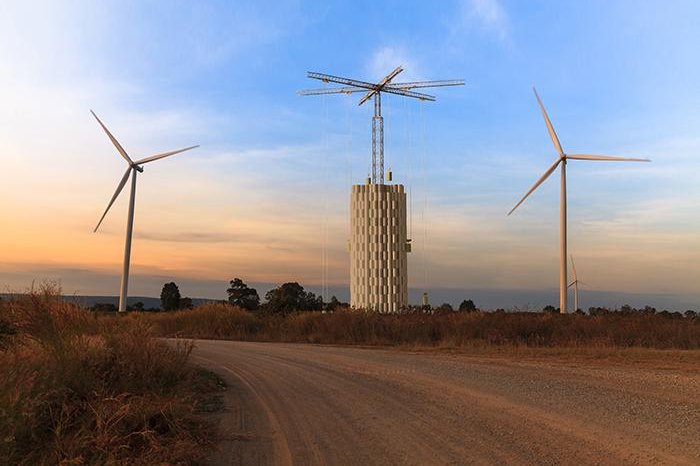A rendering of the storage system designed by Energy Vault to make renewables more stable and cheaper. The first tower operating commercially will be built in partnership with India's Tata by mid-2019, the company said. Photo courtesy of Energy Vault
Nov. 14 (UPI) -- A Swiss company has developed a concept to make wind and solar energy more stable by a combination of bricks, a crane and gravity.
"For the first time, it allows production of energy from renewables at a cost below fossil fuel, regardless of whether the sun is shining or the wind blowing," Robert Piconi, CEO of Energy Vault, told UPI Wednesday.
"It supports any type of renewable," he added. Unlike batteries, there are no chemicals involved. The system just uses excess energy to raise bricks to store energy, and lowers them to release it.
The system builds upon the concept of pumped-storage hydroelectricity, developed in Switzerland and Italy in the 1890s, and later spread worldwide. Energy Vault is based in Lugano -- an Italian-speaking area of Switzerland.
With pumped hydro, energy is stored by the use of two reservoirs of water at different levels. When energy generation is at a peak, water is pumped up. When the energy is needed, the water is lowered.
While building a pumped hydro system can be expensive, and the right topography is needed, the company "replicated the benefits of pumped hydro," but aiming to increase efficiency, as pumped hydro only returns about 70 percent of the power.
The new system is also approximately 50 percent to 70 percent lower cost than pumped hydro, Piconi said.
To replicate the effects of a pumped hydro system, when there is extra energy "we use a crane to lift concrete blocks, and then we can discharge them," he said. The water movement is replaced by weight.
"A 120-meter crane works with six arms that can raise or lower the concrete blocks, each weighing about 35 metric tons and thus storing 1 full MW of power," Piconi said. The bricks can be made from concrete debris to reduce costs, as about 5,000 are needed per unit.
"When concrete blocks are lowered, the Energy Vault system can generate 4-5 MW of power continuously," Piconi said.
Energy Vault, which has a prototype built in Switzerland, has signed an agreement with Tata Power -- India's largest integrated energy company -- to have the first commercially operating tower by mid-2019.
In addition, it partnered with Mexican cement maker CEMEX, which operates in more than 50 countries, to help build bricks with concrete, and alternative materials, as well as to aid with logistics.
There are three towers designed, with 10 MW, 20 MW and 35 MW hours of capacity, he said. Multiple towers can operate with a single software platform.
The system can be about five times cheaper than current alternatives, when long-term maintenance and replacement costs are considered, he said.















